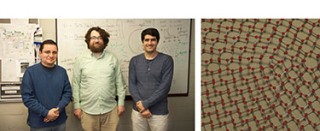May 8 2015
A research team from University of Arkansas has proposed a new method for modeling 2D structures more accurately through geometry. This new approach allows them to conclude how shape differences affect properties of atomic materials.
 From left, Salvador Barraza-Lopez, Edmund Harriss and Mehrshad Mehboudi. At right, a non-planar phosphorene segment with red balls representing phosphorus atoms connected by covalent bonds. (Photo by Amy Schlesing)
From left, Salvador Barraza-Lopez, Edmund Harriss and Mehrshad Mehboudi. At right, a non-planar phosphorene segment with red balls representing phosphorus atoms connected by covalent bonds. (Photo by Amy Schlesing)
The study was headed by Salvador Barraza-Lopez, a University of Arkansas assistant professor of physics; Edmund Harriss, clinical assistant professor of mathematics; Mehrshad Mehboudi, doctoral student in microelectronics and photonics; Kainen Utt, mathematics and physics undergraduate, and collaborators Alejandro Pacheco San Juan of Universidad del Norte in Colombia and Humberto Terrones of Rensselaer Polytechnic Institute in New York.
Phosphorene is a phosphorous layer of one atom thickness. The novel material has been attracting a lot of interest in the recent past ever since researchers discovered that the conductive properties of the novel material graphene tended to deteriorate upon being shaped. Although both phosphorene and graphene exhibit semiconductive properties, the mesh-like structure of phosphorene ensures smooth and uniform flow of energy across its surface.
The research team mapped phosphorene using discrete differential geometry. The positions of each phosphorous atom were used to model the impact of shape variations on the material’s atomic properties.
“We’re studying the shape of the material. This is the first study of its kind using discrete differential geometry to study two-dimensional material,” Barraza-Lopez said. “All that has been known of this has been based on a continuum, an ideal plane.”
Phosphorene’s atomic structure consists of valleys and ridges, and is certainly not a perfect plane. The discrete differential geometry enables creating a map of the material’s atomistic shape, and relating this shape with the variations in the material’s optical properties (light absorption behavior). Computer animation uses discrete differential geometry. In this work, the team has clearly illustrated the use of discrete differential geometry to study 2D materials.
“We can use this framework across other materials,” Harriss said. “One of the goals of the research is to fundamentally change how people model these materials.”
“There is great excitement in exploring a wealth of two-dimensional atomic structures right now, especially when their shape is not ideal and planar” Barraza-Lopez said.
“We remain certain that the research community will realize the potential of a discrete geometry in understanding shape/properties relations in those materials. There is a sense of joy in reexamining our basic understanding of geometry, using an intriguing two-dimensional material that is being extensively studied at the present moment for this purpose.”